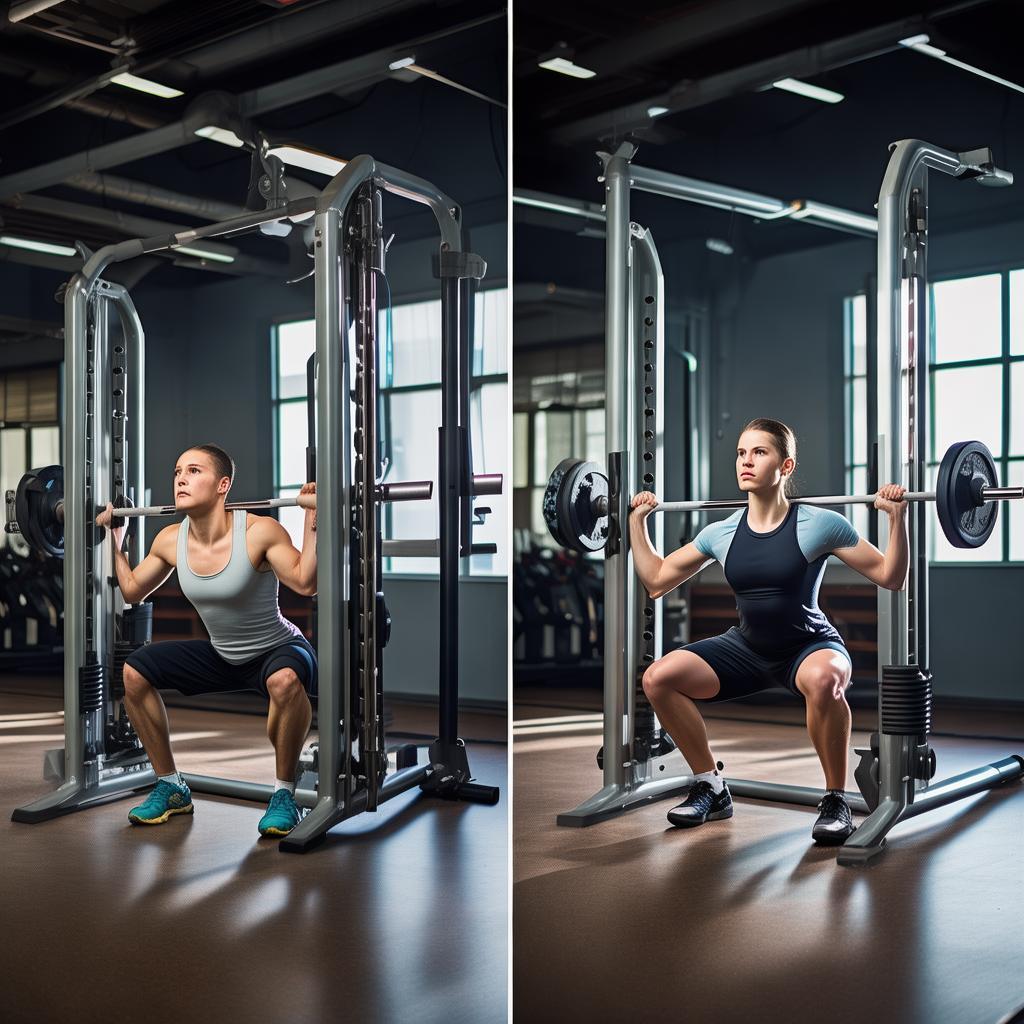Introduction
The topic of squatting in the fitness realm is extensive. You might have read numerous articles on squatting techniques and perhaps grasped the basic squatting essentials. When heading to the gym for squats, you often face a choice between two types of equipment: the Smith machine for squats and the free – standing squat rack for squats. Have you ever pondered the differences between them? Which one is more effective for squatting? Some fitness – enthusiasts are accustomed to using the Smith machine for deep squats and are reluctant to try the free squat rack. However, this approach is rather limiting.
Differences between Smith Machine Squats and Free Squat Rack Squats
1. Weight
Whether you’re squatting, bench – pressing, or even dead – lifting, you may feel that the Smith machine allows for more pushing, pulling, and squatting weight. This is because the Smith machine barbell has a fixed movement trajectory and pulleys, enabling you to borrow a bit of force. For beginners, this is particularly disadvantageous. If you start by adapting to the Smith machine’s squat power movement pattern, it will be challenging to perform free squats later, making you more prone to injuries.
2. Neurological Adaptations
If you initially favor the Smith machine for deep squats, your body will adapt to the power mode it provides. As mentioned before, if you suddenly decide to use the free squat rack for deep squats, your nervous system will be highly unaccustomed. The nervous system has a remarkable memory ability. If it’s used to performing a task in a certain way, it will remember. When suddenly presented with a new task, it needs time to adapt, resulting in less effective deep squats on the squat rack.
3. Slight Differences in Muscle Group Activation
The barbell movement trajectory determines that, strictly speaking, free deep squats, dead – lifts, and bench – presses are different from Smith machine deep squats, dead – lifts, and bench – presses. In most cases, I recommend free deep squats on the squat rack. The main difference is that one has a relatively fixed movement trajectory, while the other has a free movement plane. When performing free squat rack squats, although the barbell moves straight up and down, you need to control this through the coordinated action of multiple muscle groups. In contrast, for Smith machine deep squats, you don’t have to worry about force coordination as the trajectory is fixed. This greatly reduces your ability to coordinate the force of various muscle groups and has little impact on improving the coordination of muscle groups, which is clearly not beneficial for enhancing athletic ability. Long – term use of the Smith machine for squats may lead to muscle imbalance, which is not conducive to training or daily life, and may also increase the risk of sports injuries during other movement training.
4. Ease of Identifying Movement Defects
Training with the Smith machine can conceal your athletic defects, while free – apparatus squats make it easier to identify them. When doing free squat rack squat training, if your core is unstable, it will cause body instability and make squatting difficult. If your ankle flexibility is insufficient, the squatting center of gravity may shift forward or backward. These defects can be detected through free squats, allowing you to improve and adjust. However, with the Smith machine, these problems may be hidden as you only need to exert force, squat, and stand up without much thought, which is generally not beneficial for you.
5. Is the Smith Machine Really Suitable for Beginners?
Some believe that the Smith machine is suitable for beginners due to its safety. In fact, this view is incorrect. Beginners need to master the essentials of movement force and the basic movement pattern. If you start training with the Smith machine, its fixed trajectory will limit your performance, and your movement pattern will be restricted to follow the machine, often resulting in incorrect movement patterns. It hinders you from mastering the movement, using the body better, and stabilizing the body, which is not conducive to developing a good movement power pattern. Beginners should use free – standing equipment for squats, which can exercise the basic body function of controlling the barbell force instead of being controlled by the barbell. Mentally, many trainers using the Smith machine develop a psychological dependency, making them resist free squats. Also, the Smith machine squat may give you a greater sense of accomplishment as you can squat heavier weights. However, these mindsets are not correct in the long run. The free squat rack also provides some protection for squats. Starting from unarmed squats, fixing the movement power mode, and gradually transitioning to free squat rack squats, from empty – bar squats to adding weights step by step, will not cause sports injuries and will lead to a more solid mastery of the movement.
Conclusion
The Smith machine has its advantages, such as better isolation of target muscle groups, higher safety, and the ability to handle greater weights. However, it is still recommended that you fully master the essentials of free squats before trying Smith machine squats, like using the Smith machine for isolated quadriceps training or challenging heavy weights without a partner’s protection. Focus on free – apparatus squats, dead – lifts, and bench – presses, master these basic action essentials and power modes, and then use the Smith machine for training as a secondary piece of equipment.





